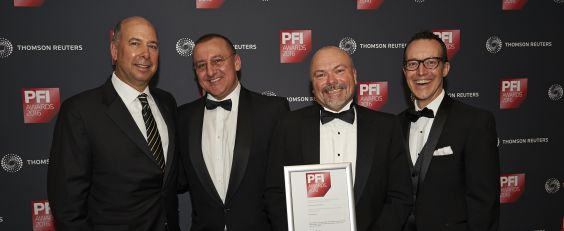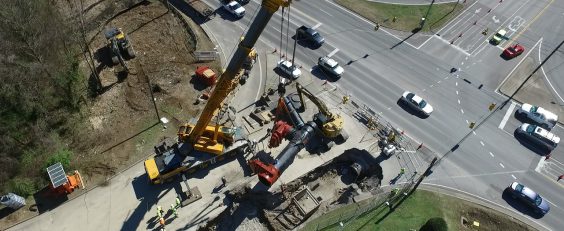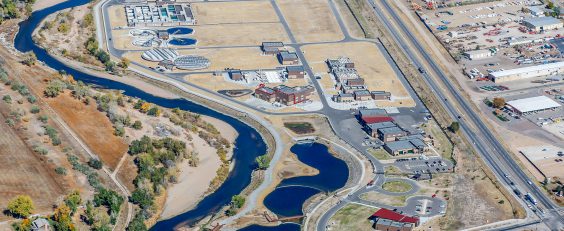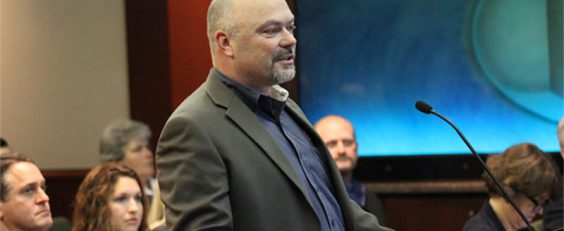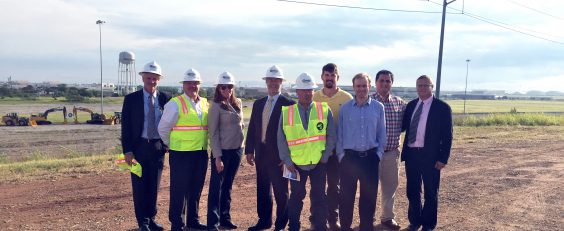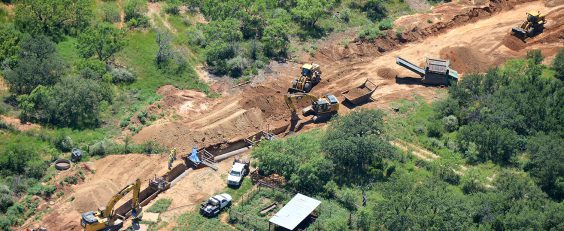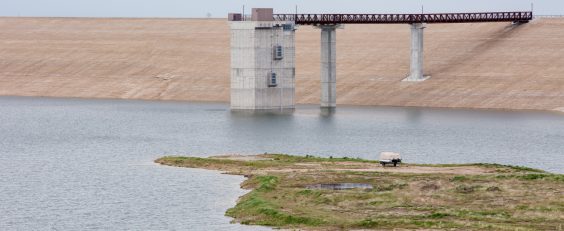Forbes Names Garney ‘Best Place to Work’
Aug 2017
Garney has claimed a spot on a new “best places” list of mid-sized employers published by Forbes. Among the top 300 U.S. employers, Garney is humbled to be recognized No. 149 on Forbes’ America’s Best Midsize Employers. Forbes’ list ranks companies with 1,000 to 5,000 employees based on a survey that asked employees how likely they were to recommend their workplaces to family or friends.
“Garney is fortunate to be 100% employee owned — it’s the foundation of our culture,” said Mike Heitmann, President and CEO of Garney Construction. “When you’re an owner, you care more about the company. It has defined our culture and our success.”
Forbes partnered with Statista to survey 30,000 employees from firms across the country on their workplace cultures.
“Garney’s employee ownership, coupled with our reputation as a leader in the industry, has created this environment where we continue to grow and invest in the development of our employee-owners.”
“We continue to see historic growth at the company. Even throughout the slowdown of the economic downturn several years ago, we continued to grow. The market we are in now is much stronger, and has put Garney in a position to grow even faster.”
For a full list of companies that earned spots on America’s Best Midsize Employers, click here.
Vista Ridge Recognized Internationally, Winning Top Water Awards
Apr 2017
APRIL 2017 – As the largest privately financed water project to close in North America to date, Vista Ridge has received top honors on a global platform. The $927 million project will support the construction of a well field, pump stations, 142-mile water pipeline, and terminus site carried out by the Vista Ridge consortium led by Garney P3 with the construction contract executed by Garney Construction.
Vista Ridge was named North America Water Deal of the Year by IJGlobal and Project Finance International (PFI). Both organizations celebrate industry excellence on a global scale, with IJ Global recognizing the best in energy and infrastructure and PFI honoring project finance professionals. Garney accepted the awards on February 1 in London and March 15 in New York.
On April 24, Vista Ridge was awarded Water Deal of the Year by Global Water Intelligence (GWI) in Madrid, Spain. Vista Ridge was up against three impressive competitors: a desalinization plant in Aqaba, Jordan; a sea-water reverse osmosis plant in Oman; and, a water treatment plant in the Bulcan Province of the Philippines.
International attention on Vista Ridge developed when the original equity partner encountered financial difficulties and Garney stepped up to assume a leadership position. San Antonio is one of the fastest-growing cities in the nation. The Vista Ridge Regional Water Supply Project remains a critical project for helping San Antonio secure their water future. Vista Ridge will expand San Antonio’s water supply by 20 percent, decreasing pressure on the sensitive Edwards Aquifer, which is subject to federal, state, and regional pumping regulations.
Water supply is expected to flow by 2020, complementing SAWS’ continued conservation efforts and development of water resources as San Antonio adds an additional one million residents by 2040.
“Vista Ridge, Garney P3, and Garney Construction are all humbled by the international recognition associated with this momentous P3 project,” said Scott Parrish, Chief Operating Officer of Garney Construction. “We look forward to successfully delivering this project on time and on budget to do our part in helping secure San Antonio’s water future.”
Nashville Crews Work Around the Clock on Cumberland City Low Water Main
Apr 2017
APRIL 2017 – In an already booming population growth, utility infrastructure in Nashville and Davidson County, Tennessee, is on the rise. In an effort to stay ahead of this growth, Metro Water Services (Metro) uses a water distribution system model to establish a Water Master Growth Plan for future improvements needed within the system.
Projecting growth models is paramount in serving Metro’s 187,000 customers. Metro’s water system is comprised of two water treatment plants with a combined capacity of 180 million gallons per day (MGD) and a distribution system containing more than 3,000 miles of waterlines.
The Cumberland City Low Transmission Water Main was developed to eliminate possible future water pressure and flow problems. The $32.9 million project is the largest monetary water main project Metro has undertaken in more than 30 years.
Garney crews are working 24 hours per day to install 27,000 LF of 10″ to 60″ ductile iron water main through major intersections in Nashville. This water main will provide the first phase of the replacement waterline to the K. R. Harrington Water Treatment Plant and will provide a redundant water main to the east side of the Stones River. Construction also includes 460 LF of 48″ and 60″ RCP stormwater pipe, 290 LF of 36″ ball and socket ductile iron pipe, dewatering for the Stones River crossing, 120 LF of 96″ horizontal directional drill liner plate tunnel under a railroad track, a tie-in to an existing 60″ PCCP water main, rock excavation, and several water service connections.
Multiple routing alternatives were evaluated and compared, with consideration given to numerous criteria including environmental, legal, water quality, permitting, property acquisition, constructability, cost, schedule, and overall impact to Metro’s customers. The selected route provided the best flow conditions and shortened the water age in the distribution system.
“Garney has further worked with Metro and design engineer, Gresham, Smith and Partners, to tremendously minimize traffic disruption on Lebanon Road and Donelson Pike,” said Cyrus Toosi, Assistant Director of Engineering at Metro Water Services. “Garney is also playing a large role in an extensive public outreach program, interfacing with residents and businesses to minimize disruption.”
$258 Million Wastewater Treatment Plant Begins Operation
Apr 2017
APRIL 2017 – A new advanced wastewater treatment plant which will eventually serve 300,000 customers across five Colorado metropolitan cities is now treating wastewater after 45 months of construction and commissioning. The $258 million plant is one of the largest progressive design-build wastewater treatment plants constructed in the United States to date.
With a rapidly growing community, Metro Wastewater Reclamation District began planning for the Northern Treatment Plant back in 1982. The new facility has capacity to treat 24 million gallons per day (MGD) with a buildout to 60 MGD.
Since construction started in late 2012, Garney has constructed more than 32 structures totaling more than 300,000 square feet of building footprint, 24 miles of yard piping, 3,000 valves, and 14 miles of interior piping that span the 100-acre site in Brighton, Colorado. Garney crews self-performed 950,000 man-hours over a 3.5 year construction period.
Construction and commissioning was completed by Fall 2016. Commissioning activities ensured the new facility would not only meet or surpass all regulatory requirements, but would also do so in an efficient and cost-effective manner. The plant has been fully operational since late September 2016.
Garney Names New Controller of Operations
Apr 2017
APRIL 2017 – Garney Construction is pleased to welcome Austin Delimont, CPA, CCIFP, as Assistant Controller of Operations. In this new role, Delimont will be responsible for managing Garney’s accounting, financial reporting, and tax compliance and reporting.
Delimont joins the Garney team after a 9-year career with CBIZ and Mayer Hoffman McCann P.C. While at the national accounting and auditing firm, Delimont was responsible for large attest engagements, assisting in the preparation of financial statements, and resolving critical audit and risk issues with a primary focus in the construction industry.
Delimont is a graduate of Kansas State University with a bachelor of science in Business Administration – Finance and Accounting. He is a Certified Public Accountant (CPA) and Certified Construction Industry Financial Professional (CCIFP). The CCIFP designation is the only accounting certification for construction financial professionals and is accredited by the American National Standards Institute. Delimont’s background, in parallel with this designation, will provide verification essential to ethical financial management in today’s complex construction industry. According to the Institute of Certified Construction Industry Financial Professionals, Delimont is one of only 900 who hold the designation nationwide.
“Austin has been recognized as one of the brightest young talents in the field,” said Jeff Lacy, Chief Financial Officer of Garney Construction. “Prior to joining Garney, he worked as Garney’s Account Manager for five years and exhibited all of the characteristics that align with Garney’s goals and philosophies. He will be a tremendous asset to the Garney team.”
Garney Reaches Financial Close on Vista Ridge Water Supply Project
Nov 2016
NOVEMBER 2016 — Financial close has been reached on the Vista Ridge Water Supply Project, allowing Garney to begin overseeing the design, construction, and financing of a 142-mile pipeline. As one of the fastest-growing cities in the nation, the 142-mile pipeline is a critical project for San Antonio as it will deliver 16.3 billion gallons of water to the rapidly growing community.
The San Antonio Water System (SAWS) board voted unanimously to consent to the financial close. Garney will continue to assume the regulatory, financial, and construction risk of the project. This public-private partnership (P3) venture is a significant milestone for Garney. It signifies Garney’s ability to invest in the financial and logistical requirements to undertake the $927 million program.
Vista Ridge will expand San Antonio’s water supply by 20 percent, decreasing pressure on the sensitive Edwards Aquifer, which is subject to federal, state and regional pumping regulations. SAWS is a national leader in water conservation, and the Vista Ridge pipeline will complement SAWS’ continued conservation efforts and development of other water resources as San Antonio adds one million residents by 2040.
Construction is set to begin in early 2017 and last through 2019, with water flowing in early 2020. SAWS and its customers will only pay for the water that actually makes it to San Antonio. After 30 years, in 2050, SAWS would own the pipeline.
“Achieving financial close is a huge milestone and development of this important project,” said Scott Parrish, Chief Operating Officer of Garney Construction. “Our team is ready to commence construction and be in a position to deliver water to San Antonio in 2020.”
Talking Shop with Tim Porter: Driving Future Growth within the Power and Industrial Market
Oct 2016
OCTOBER 2016 – Since joining Garney six months ago, Tim Porter has developed impressive growth within the power and industrial market. Porter joined Garney in April 2016 as Business Development Manager with a sole focus to broaden Garney’s client base in the power and industrial market sector throughout the United States. He brings 27 years of experience in the private sector, primarily within the power market delivering large-scale water supply and related infrastructure. This week, Porter sat down to share insight on the direction of the market and the plan for the future.
With more than 27 years of private and industrial construction expertise, what prompted you to join Garney?
Garney is a national leader in the water resource market. With the power and industrial market on a slow but steady comeback, I saw Garney in a great position to where I could help leverage Garney’s leadership role, national footprint, and established industry relationships within the market sector.
What have you learned at Garney within the past six months that will drive future growth in the private market sector?
As a previous competitor of Garney’s, I was surprised to learn the level of commitment to attracting bright young talent. Combining this with the long-term experienced ‘gray beards’ is a solid package for growth.
One challenge is transitioning some of the relationship capitol of the established individuals so the company can maintain a network of layers with our clients and engineering partners.
How will you leverage Garney’s expertise in water and wastewater infrastructure within this market segment?
We have already begun by bringing young talent to lead complicated power and industrial projects. This exposure will pay dividends for many years to come. It also creates an urgency for managers to share their skills and expertise. The challenge is this requires more time from an already stretched contingency of the company.
From your perspective, what challenges must the power and industrial market overcome with regard to stringent regulations in maintaining existing infrastructure?
The complete lack of a comprehensive energy plan in our country has hindered the power market for nearly all of my career. Regulatory impacts and unrealistic timelines have forced closures of many valuable assets within the coal and nuclear segment prior to the end of their anticipated design life. These types of assets will not be easily rebuilt in a pinch.
Garney stands to benefit from the most recent regulatory assault. The new ELG (Effluent Limitation Guidelines) regulations will prohibit coal-fired power plants from discharging ash related effluent through current permitted outfalls. This in itself creates pipeline and treatment opportunities, but the short deadline creates urgency that will consume all of the capable contractors and vendors’ resources. Garney is working to position ourselves to capitalize on this perfect storm via strong joint venture agreements and building new relationships with Owners.
What is unique about working in the power and industrial market?
The power and industrial markets present tough projects with tight timelines that force contractors to hit the ground running with very little design completed. Contractors who stub their toe early can face crippling damages along with being ostracized in the industry.
What is your strategy for success?
It may sound simple, but I believe in showing up. So many people are content to work through email and long distance communication. It is nearly impossible to build a strong relationship and garner the type of insight necessary to solve a client’s issues from afar. Once you show up, be a resource. There are plenty of vendors who will buy lunch but fail to deliver any value. If you spend time with the client, it is almost impossible not to learn about the business. Once you do that, try to understand what they want before you get to what you want.
Federal Momentum Rises with Groundbreaking at Tinker Air Force Base
Oct 2016
OCTOBER 2016 – Work is officially underway with the groundbreaking of the new KC-46A Tanker Sustainment Campus at Tinker Air Force Base in Oklahoma City, Oklahoma. This future depot maintenance facility will be home to the Air Force’s next-generation aerial refueling aircraft, the KC-46A Pegasus. The Contrack Watts / Garney Federal joint venture will construct $36 million in new utility infrastructure for the depot maintenance facility, including water, wastewater, industrial waste, storm, and dry utilities. This project marks the first of several military construction projects to deliver KC-46 capabilities to Tinker Air Force Base. The KC-46A Pegasus, designed by Boeing, will refuel military aircraft while employing multiple layers of protection to detect and defeat in medium-threat environments.
The 158-acre campus will provide a number of hangars, ramp infrastructure, software innovation labs, and engine test facilities. This facility will benefit the nation’s generations for years to come, and will generate more than 1,300 new jobs for the State of Oklahoma. The Contrack Watts / Garney Federal team anticipates completing construction by spring 2018.
This is a milestone project for Garney Federal. “We are excited to serve our Air Force through this Army Corps of Engineers contract,” said Jay McQuillen, P.E., President of Garney Federal. “Working with our pipe operations and industry partners, we see this as an opportunity to add the Federal customer to Garney’s already successful public client operations. This project will carry us well into 2017, and allow Garney Federal to build Government contracting capabilities.”
Learn more about the KC-46A Tanker Sustainment Campus and how the KC-46A Pegasus tanker will provide security for our nation’s defense.
CMAR Delivery Boosts Water Supply Amid Scarcity in Texas
Oct 2016
OCTOBER 2016 – The year 2014 marked one of the worst droughts in Texas history, driving the City of Abilene, Texas, to initiate the PK Second Stage Drought Strategy project to develop available water sources.
Stage One of the City’s plan, the Hamby Water Reclamation Facility and Indirect Reuse project, was completed in 2015 providing much needed relief to the area. The raw water augmentation from the Hamby project only offset 25 percent of the daily water demands, which was not enough to counteract the historic drought.
Enprotec / Hibbs & Todd, Inc. (eHT) was tasked to develop the design for improvements to use brackish raw water from Possum Kingdom Lake and desalinate the raw water to a sufficient level to match current raw water quality from Hubbard Creek Reservoir. The City’s goals required upgrading the existing Possum Kingdom Lake intake pump station, owned by the Brazos River Authority, installation of 42 miles of raw water, product water and concentrate pipelines, and a raw water roughing facility (RWRF) designed to desalinate raw water prior to final conventional water treatment.
With the City’s objective to start using Possum Kingdom Lake water no later than the summer of 2015, eHT determined Construction Manager at Risk (CMAR) delivery would be vital in meeting the project’s aggressive schedule. Garney was selected as the CMAR through a value-based selection process in late 2014 and worked with eHT to fast-track the schedule. This included purchasing long lead materials and developing subcontracted scopes while final design was underway. Features of this critical project included:
RAW WATER PIPELINE: 48,890 LF of 36-inch C303 bar wrapped pipe, 565 LF of 48-inch steel cased bores, two connections to existing facilities, blow-off and ARV appurtenances
PRODUCT WATER PIPELINE: 36,730 LF of 36-inch C303 bar wrapped pipe, 3,374 LF of 36-inch HDPE horizontal directional drill (HDD), 804 LF of 48-inch steel cased bores, four connections to existing facilities, blow-off and ARV appurtenances
CONCENTRATE PIPELINE: 70,332 LF of 12-inch PVC pipe, 13,300 LF of 14-inch HDPE, 45 HDDs, outfall structure, and ARV appurtenances
Construction of the 36-inch raw water and product water pipelines was completed in November 2015 allowing the transfer of water to the City of Abilene. Today, the City continues to take a leadership role within the region by exploring opportunities with eHT and Garney to conserve available water supply. With water security becoming a growing issue in West Texas, the City remains diligent in determining solutions to provide additional water now, and for future generations to come.
“The City of Abilene is proud to have implemented a second stage short-term drought response strategy that included 30 miles of raw water, product water and concentrate pipelines along with the construction of a Raw Water Roughing Facility designed to partially desalinate raw PK water prior to being sent to Abilene for final, conventional water treatment,” said Tommy O’Brien, Executive Water Utilities Director for the City of Abilene. “Critical challenges that were successfully met include fast-track design and construction of a Reverse Osmosis system.”
Senate Passes Water Resource Development Act
Oct 2016
OCTOBER 2016 – Following years of action by a diverse alliance of water sector organizations, the Water Resources Development Act (WRDA) of 2016 has passed with strong bipartisan support. This is a crucial step to investing in the future of water infrastructure. The bill passed with a 95-3 vote on September 15 and is now pending consideration by the House.
Since the development of this bill, Garney has maintained an active presence in voicing support through local congressional representatives. If passed, this hallmark legislation will authorize new and existing water infrastructure financing through fiscal year 2021. Impactful authorizations and reforms to the bill include:
- Investment in U.S. Army Corps of Engineers water resources and conservation projects including: navigation, flood management, and ecosystem restoration
- Aid in reducing communities’ public health risks and rural drinking water systems
- Development of financing for innovation in water technology
Learn more about the importance of this bill and its potential impact through the Library of Congress.

